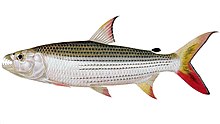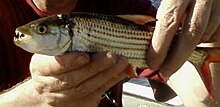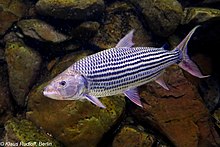Hydrocynus vittatus
| African tiger fish | |
|---|---|

| |
| Scientific classification | |
| Domain: | Eukaryota |
| Kingdom: | Animalia |
| Phylum: | Chordata |
| Class: | Actinopterygii |
| Order: | Characiformes |
| Family: | Alestidae |
| Genus: | Hydrocynus |
| Species: | H. vittatus
|
| Binomial name | |
| Hydrocynus vittatus (Castelnau,1861)
| |
| Synonyms[2] | |
| |
Hydrocynus vittatus,theAfrican tigerfish,tiervisorngwesh[3]is a predatory freshwater fish distributed throughout much of Africa. This fish is generally apiscivorebut it has been observed leaping out of the water and catchingbarn swallowsin flight.[4][5]
Taxonomy
[edit]Hydrocynus vittatuswas first formallydescribedasHydrocyon vittatusin 1861 by the FrenchnaturalistFrançois-Louis Laporte, comte de Castelnauwith itstype localitygiven asLake Ngamiin Botswana.[6]The genusHydrocynusis placed in thefamilyAlestidaewithin thesuborderCharacoideiin theorderCharaciformesby the 5th edition ofFishes of the World.[7]Some authorities placeHydrocynusin thesubfamilyAlestinae,[8]but the 5th edition of Fishes of the World does not recognise subfamilies in the Alestidae.[7]
Etymology
[edit]The genus name,Hydrocynus,is a Greek compound word ofhydro,meaning "water", andkyon,which means "dog". This is a calque of theEgyptian Arabicname for thetype speciesof the genus,H. forskahlii,Kelb el bahr,meaning "water dog". This name refers to the predatory behaviours of that species. Thespecific name,vittatusmeans "banded", an allusion to the blue horizontal stripes along the flanks of the African tigerfish.[9]
Appearance
[edit]Hydrocynus vittatusis overall silvery in colour, with thin black stripes running horizontally. It has an elongated body and a red, forkedcaudal finwith a black edge. Its head is large, as well as its teeth, of which there are eight per jaw. The teeth are sharp and conical, which are used to grasp and chop prey.[10]They are able to replace their teeth simultaneously on the upper and lower jaws.[11]Males are larger and more full-bodied than females.[10]It grows to a length of 105 centimetres (41 in)SL.[3]
Distribution
[edit]Hydrocynus vittatushas a distribution which covers theNiger/Bénoué,Ouémé River,Senegal River,Nile,Omo River,Congo River,Lufira,Lualaba River,Luapula,Zambezi,Limpopo River,Rovuma,Shire RiverandWami River;as well as Lakes -Lake Bangweulu,Mweru,Tanganyika,Upemba,RukwaandMalagarazi.It is also found in theOkavango Basinand lower reaches of coastal systems south to thePongola Riverand in man-madeLake Kariba,Lake JoziniandSchroda Dam.[3]
Ecological significance
[edit]Hydrocynus vittatusis an important food and income source for locals. Not only do they provide a natural source of protein, the presence of the fish also promotes tourism through recreational andsport fishing.As a result of their ecological and economic importance, African tigerfish have been extensively studied by conservation groups and university researchers.[11]
Habitat and ecology
[edit]Hydrocynus vittatusmainly live near the bottom of the largefreshwaterrivers and lakes they inhabit.[1]During the day they tend to be found closer to the surface and then move towards the bottom at night.[11]They thrive in highlyoxygenatedwater in warm climates.[1]
Population and conservation status
[edit]Hydrocynus vittatusis common and widespread over most of its range. In the most studied population, that ofLake Karibaon the MiddleZambeziRiver, the population fluctuated markedly, apparently in direct relation to the abundance of the introducedclupeidLimnothrissa miodonwhich forms a major part of its diet. There is a commercial fishery inLake Rukwa,where it forms about 3.9% of the yield.
African tigerfish have declined in some river systems in southern Africa as a result of pollution,water abstractionand obstructions by dams andweirsthat prevent migration. It is locally threatened by unregulatedgillnetfisheries and has been placed on the South African protected species list. In east Africa, threats to populations include overfishing, reductions in water quality due to agricultural activities and deforestation, andpesticide pollution.[1]According to theIUCN Red List of Threatened Species,tigerfish are of least concern with a wide distribution but are protected in some reserves.[11]
Behaviour
[edit]Hydrocynus vittatuscan be found roaming the waters inschoolscontaining smaller, similar sized fish. Larger African tigerfish tend to live and hunt alone.[1]The breeding habits of this fish are somewhat elusive[11]but it is thought that breeding may take place over a couple of days during December or January. The timing depends on when the rivers and streams begin toswelldue to the start of therainy season.Females will lay their eggs insubmerged vegetationin shallow water close to the shore.[1]Hatchling African tigerfish will remain in the safety of the vegetation until the water levels become low enough to force them further into the water.[1]These fish maymigrateup to 100 km within the stream or river they inhabit.[12]
Feeding behaviour
[edit]Hydrocynus vittatusare fierce hunters and are mostlypiscivorous,and tend to eat whatever fish is most available. Smaller fish will hunt in large schools, while larger African tigerfish hunt alone. Favoured prey fish includecichlids,gobies,carp,andclariid catfish.Insectsandzooplanktonmay also be part of the African tigerfish's diet, especially during juvenile stages of life.[1][11]
A highly unusual feeding behavior has been confirmed in theSchroda Dampopulation ofHydrocynus vittatus:the fish jump out of the water and catchbarn swallowsHirundo rusticaon the wing as they fly near the surface of the lake feeding on insects. This behaviour was speculated previously, but this was the first time it had been observed during a specific research project. The researchers observed an average success rate of 25% for predation attempts, with as many as twenty birds caught per day over a relatively small lake (4.1 x 106m3). African tigerfish were observed to pursue the birds from the surface further below the water. The depth of pursuit will affect the fish's perception of the bird due tolight refractionin the water. It is thought that these tigerfish will pursue the bird at a depth that allows the individual to perceive the birds the easiest. This instance is the only documented example of a freshwater fish exhibiting this particular behavior.[4][5]Other freshwater fish have been observed catching birds that are swimming or floating on the water, but not catching them mid-flight.[4][5]
Pet trade
[edit]Hydrocynus vittatushas a ferocious appearance, which may lead people to be tempted to keep the African tigerfish as a pet. However, this is generally not recommended and should only be attempted by those with advanced skills in keepingfreshwater aquariums.[10]These fish can get quite large and require at least a 2,400 L (530 imp gal; 630 US gal) tank.[10][13]They do not get along well with any fish smaller than them (even of their own species) since smaller fish make up a majority of their diet.[10]As they grow larger, these fish can become very difficult to handle. This is especially true because of their aggressive nature and sharp teeth.[13]Anyone set on having one needs to check the local wildlife laws to determine if import of this fish is legal. In the United States, importing this species intoTexas,Utah,andFloridais illegal.[14][15]
References
[edit]- ^abcdefghAzeroual, A.; Cambray, J.; Getahun, A.; et al. (2019)."Hydrocynus vittatus".IUCN Red List of Threatened Species.2019:e.T181744A84240374.doi:10.2305/IUCN.UK.2019-3.RLTS.T181744A84240374.en.Retrieved12 November2021.
- ^"Synonyms of Hydrocynus vittatus Castelnau, 1861".Fishbase.Retrieved6 April2017.
- ^abcFroese, Rainer;Pauly, Daniel (eds.)."Hydrocynus vittatus".FishBase.December 2013 version.
- ^abcO'Brian, G.C.; Jacobs, F.; Evans, S. W.; Smit, N. J. (2013). "First observation of African tigerfishHydrocynus vittatuspreying on barn swallowsHirundo rusticain flight ".Journal of Fish Biology.84(1): 263–266.doi:10.1111/jfb.12278.PMID24354922.Includes a video.
- ^abcElla Davies (13 January 2014)."African tigerfish catch swallows in flight".Nature News.BBC.Retrieved13 January2014.Includes a video.
- ^M. le comte F. de Castelnau(1861).Memoire sur les Poissons de l'Afrique Asutrale(in French). Paris: J -B. Bailliere et fils. pp. 65–66.
- ^abNelson, J.S.;Grande, T.C.; Wilson, M.V.H. (2016).Fishes of the World(5th ed.). Hoboken, NJ:John Wiley & Sons.p. 196.doi:10.1002/9781119174844.ISBN978-1-118-34233-6.LCCN2015037522.OCLC951899884.OL25909650M.
- ^van der Laan, Richard (December 2017).Freshwater fish list(PDF)(23rd ed.). p. 997.ISSN2468-9157.
- ^Christopher Scharpf (9 March 2024)."Family ALESTIDAE Cockerell 1910 (African Tetras)".The ETYFish Project Fish Name Etymology Database.Christopher Scharpf.Retrieved28 April2024.
- ^abcdeAfrican Tiger Fish, Animal-World Pet and Animal Information
- ^abcdefSmit, N.J.; Wepener, V.; Vlok, W.; Wagenaar, G.M. (Jan 2013)."Conservation of tigerfish,Hydrocynus vittatus,in the Kruger National Park with the emphasis on establishing the suitability of the water quantity and quality requirements for the Olifants and Luvuvhu rivers ".Water Research Commission.
- ^Hydrocynus vittatus,Encyclopedia of Life
- ^ab"Hydrocynus vittatus".Seriously Fish.
- ^Tropical Fish Keeping
- ^African Tiger FishHydrocynus vittatus,Live Aquaria
External links
[edit]- Phillipson, David W. (1975).Mosi-oa-Tunya: A Handbook to the Victoria Falls Region.Longman.ISBN978-0-582-64170-9.OCLC2639131.



